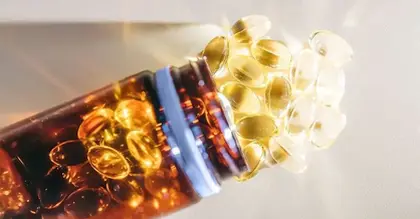
Clinical trial finds that NR supplementation could lead to clinical improvements in Parkinson’s. Image credit: Hinterhaus Productions/Getty Images.
- More than 10 million people globally have Parkinson’s disease.
- There is currently no cure for Parkinson’s disease.
- For a few years, researchers have been looking at the energy molecule nicotinamide adenine dinucleotide (NAD+) as a possible treatment for the condition.
- A phase 1 clinical trial has found a high dose supplementation of NR, a form of vitamin B3, helps increase NAD+ levels in people with Parkinson’s disease.
- The NR supplementation may be associated with clinical symptom improvement of Parkinson’s disease.
Researchers estimate that more than 10 million people around the world have Parkinson’s disease, making it the second most prevalent neurodegenerative disease after Alzheimer’s disease.
There is currently no cure for Parkinson’s disease. Medications,
Over the past few years, researchers have also looked at nicotinamide adenine dinucleotide (NAD+) — an important molecule that helps the body create energy — as a possible treatment for Parkinson’s disease.
Previous research suggests people with Parkinson’s may have a
Now, a phase 1 clinical trial has found that a high dose supplementation of
The study was recently published in the journal
According to Prof. Charalampos Tzoulis, professor of neurology and neurogenetics at the University of Bergen and Haukeland University Hospital, Bergen Norway, and co-lead author of this study, NR is a form of vitamin B3 and a precursor of NAD+.
“NAD+ is an essential coenzyme that plays a vital role in multiple cellular processes, including mitochondrial function — the powerhouses of the cell — and cellular energy metabolism, regulation of gene expression, and DNA repair,” Dr. Tzoulis explained to Medical News Today.
“Research has shown that abnormal energy metabolism, due to dysfunction in the mitochondria, occurs in the Parkinson’s disease brain and is believed to play a role in the initiation and progression of the disease,” he added.
Dr. Daniel Truong, a neurologist and medical director of the Truong Neuroscience Institute at MemorialCare Orange Coast Medical Center in Fountain Valley, CA, and editor-in-chief of the Journal of Clinical Parkinsonism and Related Disorders, who was not involved in this study, told MNT that NAD+ levels tend to
“Some potential benefits and uses associated with NR include anti-aging, energy metabolism, mitochondrial function, [and] DNA repair,” Dr. Truong detailed. “Some research suggests that NR might have neuroprotective properties.”
This study was part of the ChromaDex External Research Program (CERP™), which donated ChromaDex’s patented NR ingredient, Niagen®, for the advancement of this research.
The phase 1 clinical trial included 20 study participants with idiopathic Parkinson’s disease. Participants received either 3,000 milligrams (mg) of NR in oral supplement form, or a placebo each day for 4 consecutive weeks.
Study participants were then assessed based on clinical and molecular measures, an electrocardiogram, and the severity of Parkinson’s disease symptoms through the MDS-UPDRS rating scale.
Researchers found that NR significantly increased NAD+ levels and modified the NAD+ metabolome in whole blood, compared to those who received the placebo.
The study also reportedly found the high-dose NR was safe and well-tolerated by study participants, and was associated with a significant improvement of clinical symptoms of Parkinson’s disease, measured by the Movement Disorder Society Unified Parkinson’s Disease Rating Scale (MDS-UPDRS), suggesting augmenting NAD+ levels may have a symptomatic anti-Parkinson’s effect.
“The study showed that treatment with high dose NR 3 gr [grams] daily is short-term safe for a month and may, therefore, be explored in larger clinical trials,” Dr. Tzoulis said. “It must be stressed that our study does not establish general safety for this NR dose, or whether it is safe to take for any period longer than 30 days. This remains to be determined in longer studies.”
“In addition, the study showed that NR 3 gr daily leads to a pronounced increase in blood NAD levels and related metabolites, without causing any adverse metabolic effects after 30 days,” he continued.
However, he cautioned that, “[w]hile NR treatment was associated with a small clinical improvement in this study, this cannot be interpreted as a sign of clinical effect, as the study was not designed to detect clinical improvement.”
One of the main purposes of this study was to determine the short-term safety of 3,000 mg NR daily.
“To harness the full therapeutic potential of NR, we need to explore higher-dose regimens,” Dr. Tzoulis said. “This study establishes the short-term safety of 3,000 mg NR daily and allows high-dose options to be explored in future therapeutic trials.”
“As for conclusive proof on the therapeutic potential of NR in Parkinson’s disease, we look forward to the results from our year-long NO-PARK phase 2/3 study on 400 persons with Parkinson’s disease, which is already ongoing at our Center and estimated to conclude by the end of 2024,” he added. “Public information on the NO-PARK study can be viewed at neuro-sysmed.no and at clinicaltrials.gov.”
After reviewing this study, Dr. Rocco DiPaola, movement disorders neurologist at the Hackensack Meridian Neuroscience Institute at Jersey Shore University Medical Center, told MNT his first reaction is that it offers a potential treatment that may help slow the progression of Parkinson’s Disease.
“There [are] currently no treatments that offer neuroprotection and this would be a treatment that may help prevent some of the long-term complications related to advancing disease. The current study was on a small scale and short duration to demonstrate safety. A large-scale trial with [a] longer duration of treatment would be necessary to further demonstrate safety and a neuroprotective benefit.”
– Dr. Rocco DiPaola
Dr. Truong agreed, noting that “[the findings are promising, but this is just one study, and its results need to be replicated and expanded upon in larger and longer-term trials, especially double-blind studies.”
“I am intrigued by the mechanism of action proposed in the study, namely the increase in NAD+ levels and its potential neuroprotective effects,” he continued. “They would be interested in how this could be integrated into current treatment protocols for Parkinson’s disease, considering the safety profile and patient tolerance.”
“Given the current status of treating Parkinson’s disease, any potential new therapeutic avenue is of interest,” Dr. Truong added. “The idea of a supplement that could improve clinical symptoms and potentially slow disease progression is particularly appealing.”





